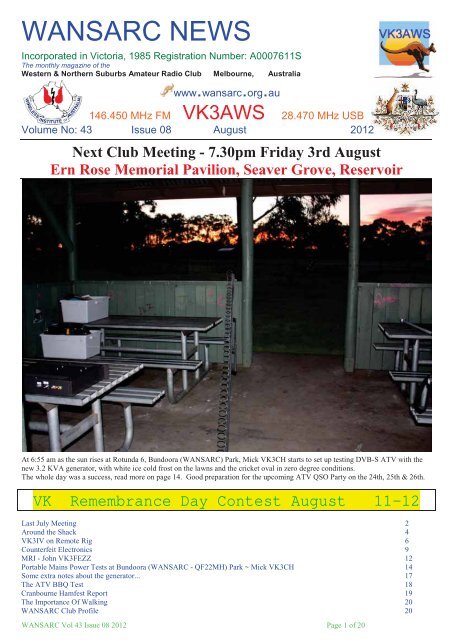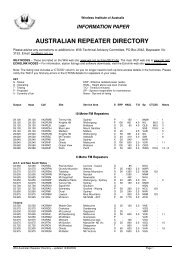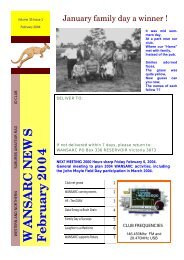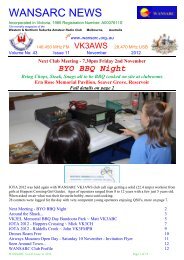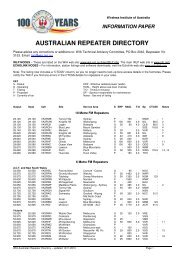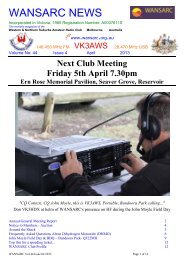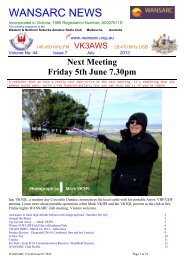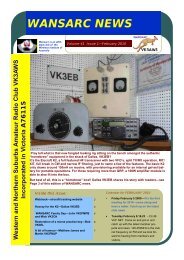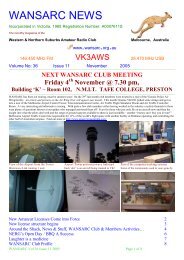August - Western & Northern Suburbs Amateur Radio Club
August - Western & Northern Suburbs Amateur Radio Club
August - Western & Northern Suburbs Amateur Radio Club
You also want an ePaper? Increase the reach of your titles
YUMPU automatically turns print PDFs into web optimized ePapers that Google loves.
WANSARC also has a digital Antenna "Z" Bridge Tuner that canbe borrowed by club members. This comes in a carry case withRod VK3FAB collecting cash, which he seems to be very good atgiven the club funds in a healthy state. <strong>Club</strong> mascot Jack visitingall the way from VK2 relaxing as the members watch the video.Boys and their toys, Don demonstrating the AR DroneAfter the meeting it was the usual banter and the crew slowlytrickled either back home or down to Crown Pizza for some foodand more tall tales or technology talk. Who says winter is boring.WANSARC Vol 43 Issue 08 2012 Page 3 of 20
Casio CE-250 Cash Register User ManualTiVo Digital Video Recorder TCD540040 Series2 User ManualHP Laserjet 4p User ManualOregon Scientific Cable-Free Moonphase Weather Clock BA928 User ManualCasio PCR-408 Cash Register User ManualMorphy Richards Compact Breadmaker 48245 User ManualLaserjet 4l User ManualSharp Copier AL-1551CS User ManualBrother Gx6750 Typewriter User ManualHP Laserjet 4 Plus User ManualKrups Cappuccino Machine 968-41 User ManualHonda Ht R3811 Lawn Tractor User ManualMorphy Richards Food Processor 48905 User ManualCasio PCR-265P(B) Cash Register User ManualHonda G100 User ManualPfaff 1245 User ManualCasio Cfx 9850g User ManualHoover SteamVac Widepath LS F6024-900 User ManualBrother LS-1520 Sewing Machine User ManualApple IMovie HD User ManualDeLonghi Steam Cleaner ST100P User ManualSharp FO-165/365/UX-107/177 User ManualOster Animal Clipper Golden A5 User ManualNikon AF-S DX 18-55 User ManualCasio KL-7200 Label Printer User ManualSamsung Camera Evoca 140S User ManualTDK DVD-Rewritable Drive DED+440 User Manual
VK3IV on Remote RigIan, VK3IV, is now residing in an aged care centre in Whittlesea. Rules and restrictions at the facility mean that putting up antennasof any kind is not allowed, even small ones. Handhelds would restrict operation to a few close repeaters and no HF.With the success of Don using Remote Rig to connect via VK2 it was decided to get Ian back on HF/VHF/UHF via Remote Rig.A second hand IC-706mkIIg rig was bought and the remote units were kindly configured by Don who says that he has tried just aboutevery configuration and knows what works best for reliable results.To keep things simple for Ian as much automation was the bestidea. So an opto-coupler was setup (a simple Jaycar kit) to take the8 volt accessory voltage from the IC-706 (only needing a milliamp,so safe and isolated from theradio) and when the radio was powered on, it picked up a relay.This then gives a visual indication in Mick VK3CH shack that theIC-706 is in use. The HF long wire antenna was then switchedvia a coaxial relay from Mick's radio over to the IC-706 withanother relay switching over the AH-4 HF auto tuner as well.A dedicated X7000 to the IC-706 gives 2 meters and 70 cm.While Ian uses the IC-706, Mick still has HF use via the verticalantennas on the IC-9100 and/or the IC-910H for VHF/UHF access.The completed Jaycar (KC-5434) Opto-The Opto-© Silicon Chip MagazineRelay with 4 contact switching for AH-At Mick's shack the Main Remote Rig Control box was plugged into the router. Its good as you don't need any PC, the Remote Rigdoes all the smart stuff on its own. You can read the article in WANSARC News - October 2010 page 8, can be downloaded fromclub website at www.wansarc.org.au Or see www.remoterig.comThe IC-706 plugs straight into the Remote Rig Control box. It was more work towire up the relay switching for the antenna than to remote the radio! Plugs arecheap, just using the plugs used for power in PC drives, which were fished backout of the junk box at the Moorabbin Hamfest just before 10am opening The last thing to do was make up patch leads from the coaxial relay and radios.A lot of spare lengths of coax was found stashed away (more stuff to sell next Hamfest.)At Moorabbin Hamfest a heap of coax connectors were bought from Ken VK3YXC. These are very good quality and absolutely perfect for HF/VHF/UHF and very easy to applyto coax, in fact these are the least trouble to work with.Testing the radio in remote mode was simple as plugging the radio box in, then the remote'head' of the radio into the same router and checking that all worked.While it looks like it's just 'talking' across the router, with the IP addresses set to their remotesettings, actual linking is going out from the shack, to the ISP, back to my ISP, then back tothe shack to jump to the next set of CAT5 pins on the router to the other remote rig interface.In real use of course the path would be Remote Local <strong>Radio</strong> Front Control Panel.The easy way to prove it was talking on the radio "head" at Dads room in Whittlesea,sending the speech to my shack in Northcote and listening to my voice coming back viaradios RF via the internet from Flemington via Andy VK3YT Software <strong>Radio</strong> listening tomyself on 40 meters on Dads laptop, only about a meter away from the microphone!As we are sending telephone type speech the bandwidth used is very little, dial up wouldsuffice for Remote Rig at either or both ends of the internet connection.RemWANSARC Vol 43 Issue 08 2012 Page 6 of 20
Electronic Resellers Association International (ERAI), a group that represents more than 1000 independent distributors, has beenworking to improve quality control among its members by, for example, setting up an escrow service, which allows buyers to inspectthe goods before completing their purchase, and by launching its own Web-based database, Parthunter.com, for locating parts. Unlikeother online trading sites, Parthunter vets its traders and alerts users when they search for a part that is known to have beencounterfeited in the past. Such activities are encouraging signs, but the fact remains that most independent distributors don't subjectthemselves to the kind of scrutiny that ERAI demands of its members.With no systematic way to defeat counterfeiting, individual companies have been fending for themselves. One of the chief defences isto rigorously monitor the supply chain. The large computer company mentioned earlier has a policy of avoiding independent partsbrokers; it tries to purchase parts directly from trusted sources--and hopes that its suppliers also purchase directly from trustedsources. Big companies that do all or part of their manufacturing in China and other parts of Asia also make efforts to police theiroperations there, often maintaining full-time staff or hiring outside services to look out for bogus parts.Identifying suspected counterfeiters is another approach. Underwriters Laboratories Inc., in Northbrook, Ill., is particularly aggressivein this area. UL is not a manufacturer but is hired by manufacturers to test and certify their products. So when a counterfeiter uses afake UL logo to lend an air of authenticity to an otherwise bogus product, UL understandably grows concerned. During the last 10years, the company's dedicated anticounterfeiting team has worked with U.S. Customs and Border Protection, the Federal Bureau ofInvestigation, and other agencies around the world to identify and seize millions of products bearing counterfeit UL marks.The merchandise seized has included not only computer components and power supplies but also lamps, extension cords, Christmaslights, fans, telephones, and radios.UL also has introduced holographic labels that it says are virtually impossible to forge. Indeed, the use of sophisticated holograms orother labelling is another way that companies attempt to thwart counterfeits. For instance, the router and networking company 3ComCorp., Marlborough, Mass., announced in January that it had begun using three-dimensional, tamper-foiling holographic labels on allits switches. But as anyone who has purchased pirated goods in China and elsewhere can attest, genuine-looking hologram labels arecheap and plentiful; even if they only approximate a real logo, the holograms lend that air of authenticity.Like many companies, 3Com also regularly posts notices on its Web site on how to identify legitimate company products. But with somany manufacturers and suppliers employing their own authenticating schemes, there is simply no way to keep up with theinformation. Who has time to check that the laser-etched serial number on a particular memory device is exactly as the chip makersays it should be? In one telling example, the outward appearance of a counterfeit lithium-ion battery for a Nikon digital cameradiffered from the real thing only in the subtly squarer shape of one of hundreds of Japanese characters on its label.Manufacturers big and small need to be doing more to ensure that the parts and modules contained within their systems are legitimate.This is particularly true for critical systems that have a safety or security function. Among the schemes proposed so far are speciallydesigned tests of individual components and finished products and aggressive identification methods to verify a component's sourceand type.Here's another recurring idea: create a licensing procedure for introducing parts into a given industry's supply chain. Anyone lackingthe license cannot sell into that supply chain. Unfortunately, the huge number of suppliers that most companies deal with today hasdeterred them from trying to implement such a scheme. In fact, in 1995, following numerous incidents of substandard componentsmaking their way into aircraft, the U.S. Federal Aviation Administration considered licensing avionics parts but rejected the idea.In any case, any company that is willing to risk financial penalties and even jail terms to sell counterfeits is unlikely to be dissuadedby administrative checks or licensing requirements.<strong>Radio</strong>-frequency identification (RFID) tags have been highly touted as a means of tracing a product's path as it zigzags through thesupply chain. The wirelessly readable RFID labels, which can encode authenticating data such as where and when the part was madeand by whom, are more informative and much harder to fake than simple bar codes, and most can be scanned from a distance, savingtime and effort. The smallest RFID, Hitachi's micro-chip, measures just 0.3 millimetres on a side, which in theory would be tinyenough to embed in many small components. But use of RFIDs demands that companies agree on a standard encoding scheme; todate that hasn't happened.A similar approach is to embed in each component software or firmware identifiers, including serial numbers, manufacture date,application code, and country of origin. After a number of fake lithium-ion batteries in digital and video cameras exploded, Nikonexperimented with embedding software in two Coolpix digital camera models sold in Japan. Details about the technology are scant,but the software reportedly read an ID number on the lithium-ion battery to confirm its authenticity and to prevent non-Nikonbatteries from being used in the camera. Such an approach, while effective, might not be popular with consumers--who probably wantthe option of using other makes of battery--or with authorities worried about anticompetitive practices.Electronics companies also are exploring technologies for identifying the resins, adhesives, and other chemicals used by the industry.Microtrace Inc., based in Minneapolis, markets a technique for tracing explosives after they have detonated. When encodednanoparticles are mixed into a resin, the data in the "microtaggants" can be read using handheld scanners, enabling the manufacturerto verify the resin's source. Whether such a scheme would work for all kinds of electronics materials, which often need to beextremely pure, isn't yet known.The other downside to all such safeguards is cost. Incorporating anticounterfeiting technology into a high-value IC or a printed-circuitboard could add at least 10 percent to the cost--too high a price for most companies, even if it means preventing the counterfeiting.And for components that sell for mere pennies, embedding even a low-cost RFID tag would be prohibitive.In short, there is no silver bullet when it comes to defeating counterfeiters. What is really needed is a constant multifaceted approach.Governments everywhere need to beef up their IP laws and, more important, enforce them. Industry representatives need to worktogether to adopt standard practices for monitoring supply chains. And companies need not only to acknowledge the extent of theproblem but to take deliberate steps--some of which are bound to be costly--to root out bogus parts from their manufacturing lines.Whenever a company falls down on the job or authorities fail to police the problem, it simply creates an opening for counterfeiters.If the goal is keep bogus products out of consumers' hands, clearly everyone needs to do more.~Michael Pecht, an IEEE Fellow, Electronic Products and Systems Centre at the University of Maryland ©WANSARC Vol 43 Issue 08 2012 Page 11 of 20
WANSARC Vol 43 Issue 08 2012 Page 12 of 20
WANSARC Vol 43 Issue 08 2012 Page 13 of 20
Portable Mains Power Tests at Bundoora (WANSARC - QF22MH) ParkWith the purchase of a portable generator for field day and out and about use, it was time to "break it in" for a day at the park.After finally getting a day on the weekend with some sunshine, Mick VK3CH took the new power source to Rotunda 6 and poweredup some DVB-S ATV as well as 100 watts on 2 meters with the IC-9100.Don VK3HDX offered some good advice on the generator such as only using high quality synthetic oil, high octane 98 fuel andthrowing out the supplied spark plug and replacing it with a decent NGK spark plug. He also said run it for about 5 hours then drainthe oil out completely to get rid of any metal filing contamination and replace the oil.So after packing everything into the car two days beforehand, on a Sunday with forecast sunshine, Mick set off to the park.As it was a clear sky morning the temperature on arrival at 6:55 am was exactly zero degrees and it stayed quite cold the whole day.On the front page you can see the white frost on the ground and cricket oval, which did not disappear until well after 10am.At 7:05 am a car drove down, looking for a BBQ spot and when they saw me they were not happy. They parked and watched me forabout 10 minutes, maybe hoping I had been there all night and was packing up. As they saw me carrying out box's and more crates ofgear they did a dummy spit and revved the guts out the car and did a nice burnout as they left. If the houses were not already awakethey were now! I had deliberately delayed the starting of the generator until around 9 am out of consideration for the local residents.Working alone, everything was setup ready over two hours, with erecting of antennas and alignment being the most time consuming.After powering on the new generator at 8:50 am it was time to test it all. VK3RTV2 was able to be reached although it wastemperamental at times. Later in the day the change to VK3RTV1 was done and the power level needed to hold that open pictureperfect was only 20% of full power, being about 2 watts (DVB-S).All working first go - needs the entire bench to fit it all With all the gear operating, IC-9100, Remote Rigged IC706,Television, ATV Transmitter, On Screen Text Display Unit and theHD Camera, current draw 240v side is 1.5 Amps (355W), increasedto 3 amps (655W) when transmitting 100 watts on 2 meters FM.The 3.2 KVA Reports on the ATV picture sent to VK3RTV2 were received from John VK3DQ, Trevor VK3ATX, Don VK3HDX, Peter VK3BFG,Jack VK3WWW and Mick VK3AY. Chris VK3FY and Jesse VK3FJPM watched via video stream on the internet on the BATC site.The ATV picture had very fine horizontal lines when looking at white images which was later found to be because of the installationof the 24 volt switch mode power supply inside the ATV TX unit right above the SR-Systems boards. Looks like some shielding isrequired. Some double sided printed circuit boards should do the job...At around midday Johnno VK3FMPB arrived and setup on HF. Later Wilfred P29AX joined him in operating and antenna tuning.Then after seeing the action on his TV at home, Mick VK3AY came down to see us as well. Generator lasts six hours on a tank.Doing some tests with the HM-50 base microphone with the IC-9100 it was found the audio was improved when the "Bass Cut" used.So another problem solved on the day.WANSARC Vol 43 Issue 08 2012 Page 14 of 20
Extra terminals added to the top of the 13.8 Johnno VK3FMPB, explaining stuff to Mick VK3AY and Wilfred P29AX Wildlife on show in the park early in the morningAll up, very successful, ready for the next field day, BBQ or Family Day with portable 240 volt power.WANSARC Vol 43 Issue 08 2012 Page 15 of 20
I don't know about you, butwhen preparing for an outing, itsalways thought that some vitalpiece of gear or a tool will beforgotten.That's why I have customisedcheck off lists for all the stuffthat is supposed to be brought.Ever since these lists have beenused nothing has been leftbehind at home.If your memory is like mine Irecommend these sort of lists tosave a lot of hassles later...Many thanks to all that had aQSO and gave reports or visitedus at the park on the day.~Mick VK3CHWANSARC Vol 43 Issue 08 2012 Page 16 of 20
Some extra notes about the generator...Only due to the incredible amount of emails received asking about the generator, here are the details of mine.Remember this thing is a Honda "clone" and depending on the skill of the builder and where he sources his components from; yourperformance, expectations, requirements and satisfaction (along with mine) may vary!!!While they say 4.4KVA, on the side of caution I consider it (without loading it up to blow it up) say its more like 3.2KVA to be safe.This is just Mick's VK3CH opinion, I'm no expert with these... (but even the yellow label on the side says "Rated Output 3.2KVA")Specifications data taken from their website;XG-SF 3700 Generator SpecificationsQuick OverviewDigital LCD Panel: Volt, Amp, Wattage, Running Time and OilLevel3 Start Methods: Electric Start, Remote Control Start and PullingRecoil StartUnleaded Gasoline GeneratorProvides 4.4kVA/3500 watts of power at peak and 3200 watts atnormal load149cc 4 Stroke Petrol EngineElectric Key or Remote Control StartRecoil Manual StartLCD Screen shows Engine Hours, Wattage and Amps being drawnDigital Inverter Technology - Fuji Micro Technology4.4 KVA Peak AC Output @ pf cos0.84.0 KVA (3.2kw) Rated AC Output @ pf cos0.8Frequency: 50Hz1 x 240V 15 Amp Outlet12 volt (8.3 amps) Outlet for Charging Car BatteriesRunning 59db at 4 Metre7 Litre Fuel TankUp to 6 Hours operation on one tank (mine gives 6 hours, 1 minute!)Oil Alert FunctionEconomy Switch for more fuel savings (yet to try this out)Heavy Duty Carry HandlesWeight 28 KgSize: 55cm x 30cm x 49cmThe one thing I like is the press button battery start, saving to yankon a pull cord, which leaves me more effort to use erecting antennas!The output is clean and no noise on the radios either TX or RXregardless of the bands used, be it MF/HF/VHF/UHF/SHF/EHF.As mentioned in the article, use good quality oil and replace itregularly to make the thing last. Also use a better spark plug thanthe one supplied. The spark plug tools supplied are flimsy and willbreak, use a proper socket set spark plug remover instead.I bought mine from a supplier in Bayswater but there are places allover VK you can get them, Bayswater was just the closest to me.They are all supplied from the same factory in China anyway.Don VK3HDX has had no problems with his so far.But Dave VK3DTS had his fail after only six hours of use.The supplier he got from is in Sydney and at present they are playingthe 'difficult to deal with' game and Dave is not impressed as it wasonly powering some fluorescent lights for the first few hours of itslife. Dave's fault seems to be in the inverter board, which is allsealed up, with faulty cheap capacitors suspected being the problem.Have a read of the Counterfeit Electronics article on page 9.So like all lower price things, you assume some risk compared to the'real deal' more expensive stuff, guess time will tell...Hope this helps...~Mick VK3CHWANSARC Vol 43 Issue 08 2012 Page 17 of 20
The ATV BBQ TestAfter making some adjustments to the mains powered ATV transmitter to stop the fine horizontal lines coming from the internalswitch mode power supply, testing was done next week at Doncaster East. Its amazing how much locations can vary, the first setupcould not get a signal back from VK3RTV1, not even on full power. Moving just FOUR meters with a better view of the mountaingave a perfect picture, only needing a quarter of full power. But the TX antenna was just the 15 element mini beam.Rough weather was forecast but we escaped the forecast hailstorms and just got a very light sprinkle of rain, but it was cold.To keep things interesting, Mick tried out his new "Smoker Chimney" BBQ, with a feed of a few folks, only the fourth time he hascooked with the new BBQ. Those watching on ATV got to see it all unfold and probably found the temptation to visit very high...With mains power, no generator used, but a way of taking everything such as a full ATV station plus radio communications andantennas plus the generator plus BBQ and food is a challenge that is being looked into, for next month's ATV QSO Party Linkup.Cooking just starting, 2kg of Lamb Chops and 2kg ofChicken Wings with AmericanStyle BBQ rub were slow cookedfor three hours along with a pair ofLamb Shanks rubbed with pepperand garlic salt in olive oil.The meat just falls off the bone.The BBQ has a pot of water at thebottom that regulates temperature.Sunny or cold rain, the temperatureyou cook in does not seem to affectit much at all, easy to plan cookingtimes, its a very clever design.Sorry, no photos of the endproduct. I got so wrapped up inthe serving and eating of them thatI just forgot to take some pictures!Trevor VK3ATX, John VK3ATV, Jack VK3WWW, John VK3DQ and PeterVK3BFG came up to comment on the signal and content of the pictures.Much thanks to Don VK3HDX for putting me on to the "Smoker ChimneyMountain" BBQ, they turn out truly amazing tasting food... ~Mick VK3CHWANSARC Vol 43 Issue 08 2012 Page 18 of 20
Cranbourne Hamfest ReportOn a foggy but warm day several WANSARC members made the trip to Cranbourne to see theHamfest. Mick VK3CH had two tables of remnants of junk to sell, with Trevor VK3ATXassisting. Crowd numbers seemed a bit lower than last year and only a quarter of the junk gotsold, but some money was still made. Mick only spent $7 on a connector, but a fewWANSARC guys spent a lot more, with some specials on mobile antennas to be had if youwere quick enough.<strong>Club</strong> members seen were VK3CN Greg, Craig VK3FZAA, Dan VK3DWH, John VK3ACA,Frank VK3ZFS, Mick VK3AY, Sam VK3JCD, Peter VK3XCO and Lou VK3ZLD.After the raffle draw the crowds soon dispersed and few WANSARC guys had a nice meal at alocal pub. But for many its was about catching up with mates as well as hunting for a bargain.TrevoALARA CONTEST 25th and 26th <strong>August</strong>All licensed operators throughout the world are invited to participate. Also open to Shortwave Listeners.YL works everyone, OMs & <strong>Club</strong>s work YLs only.One contest (combined phone and CW) run over 20 hours.Saturday 25th <strong>August</strong> 0400 hours UTC to 1359 hours UTCSunday 26th <strong>August</strong> 0400 hours UTC to 1359 hours UTCBands to be used are 3.5, 7, 14, 21 and 28 MHz only.The following are suggested frequencies for easier location of contacts:28.38 to 28.41 21.17 to 21.2 and 21.38 to 21.41 14.25 to 14.28 7.07 to 7.1 3.56 to 3.59(Jean Fisher VK3VIP President & State rep ( VK3) for A.L.A.R.A.)WANSARC Vol 43 Issue 08 2012 Page 19 of 20


